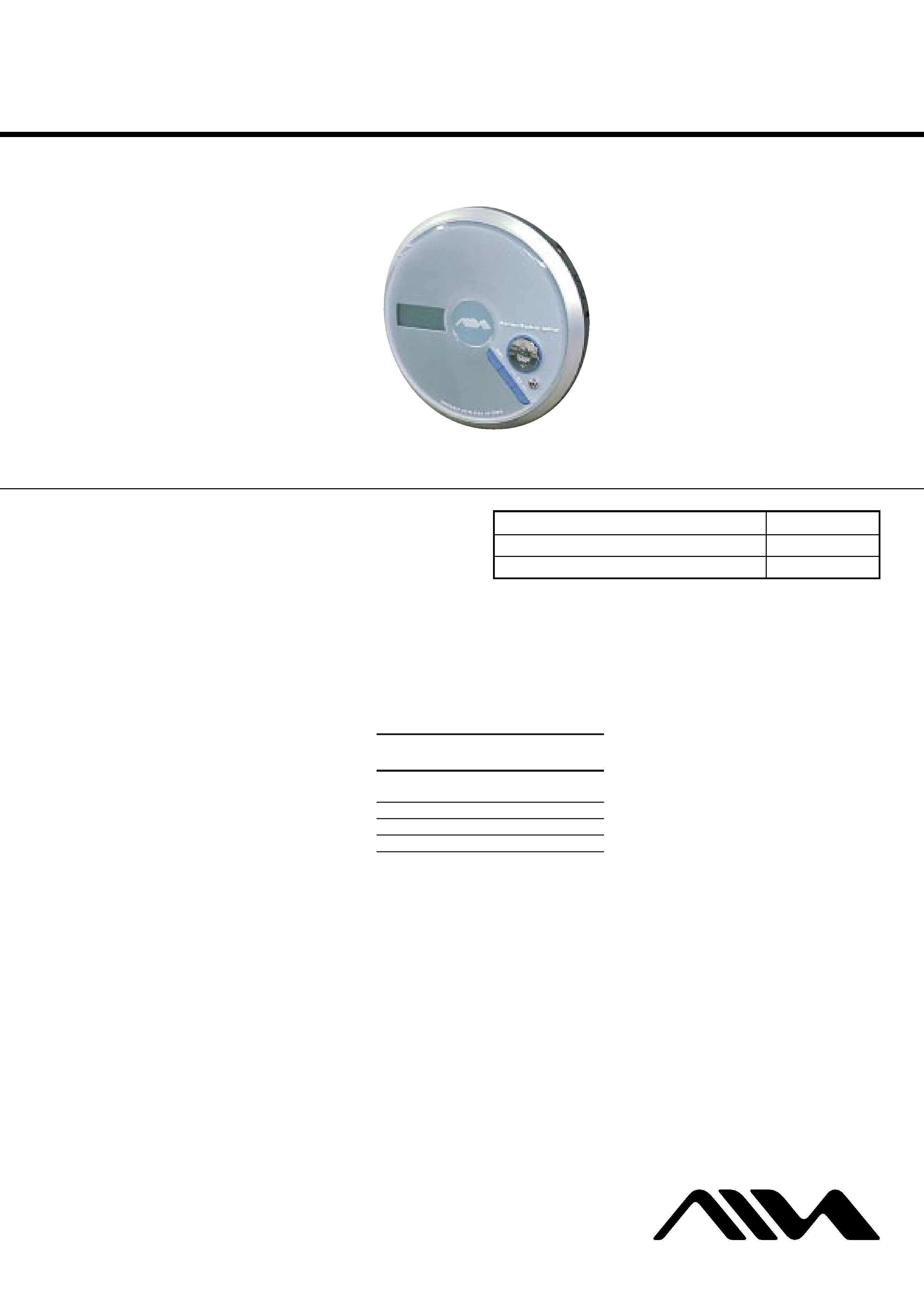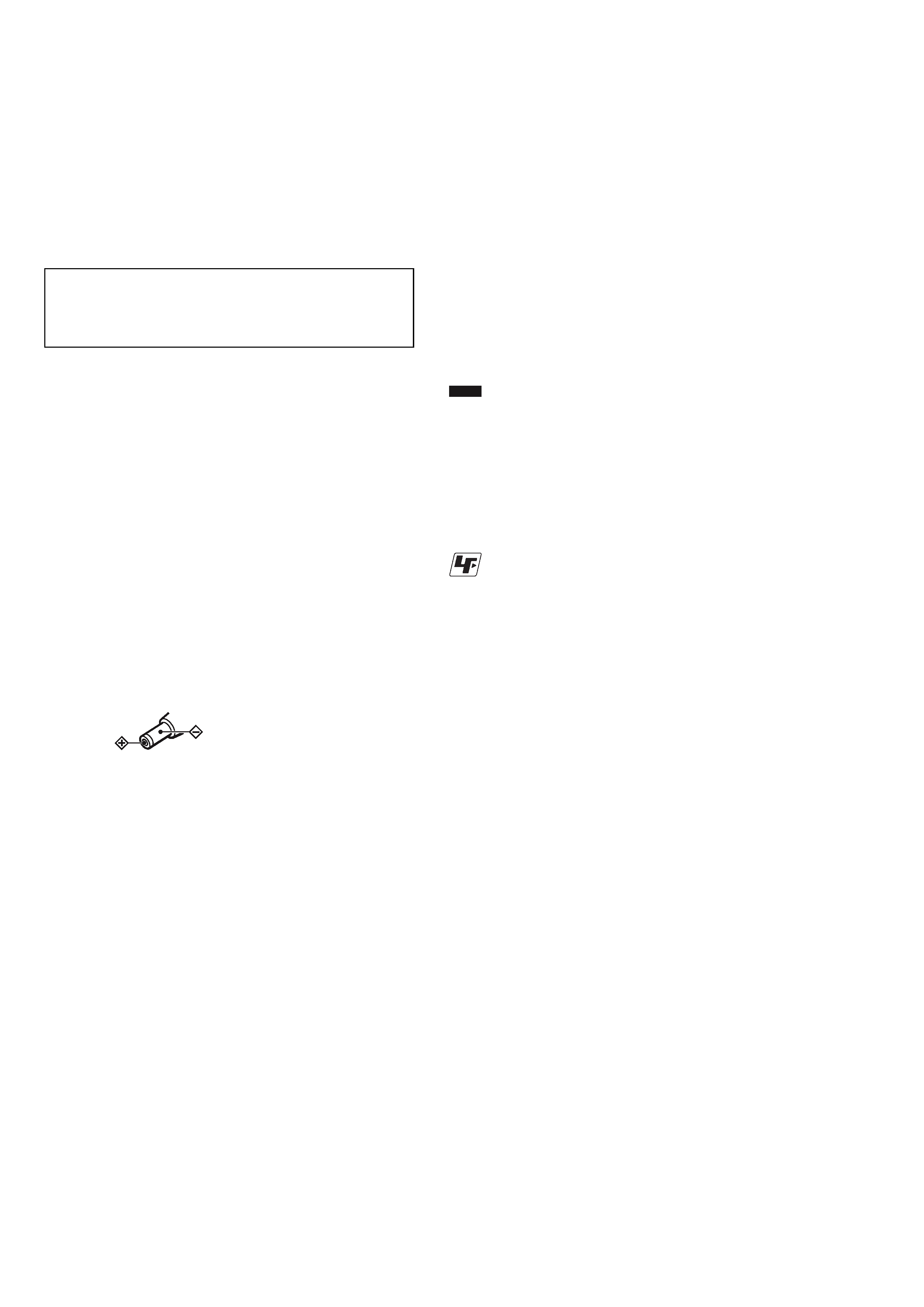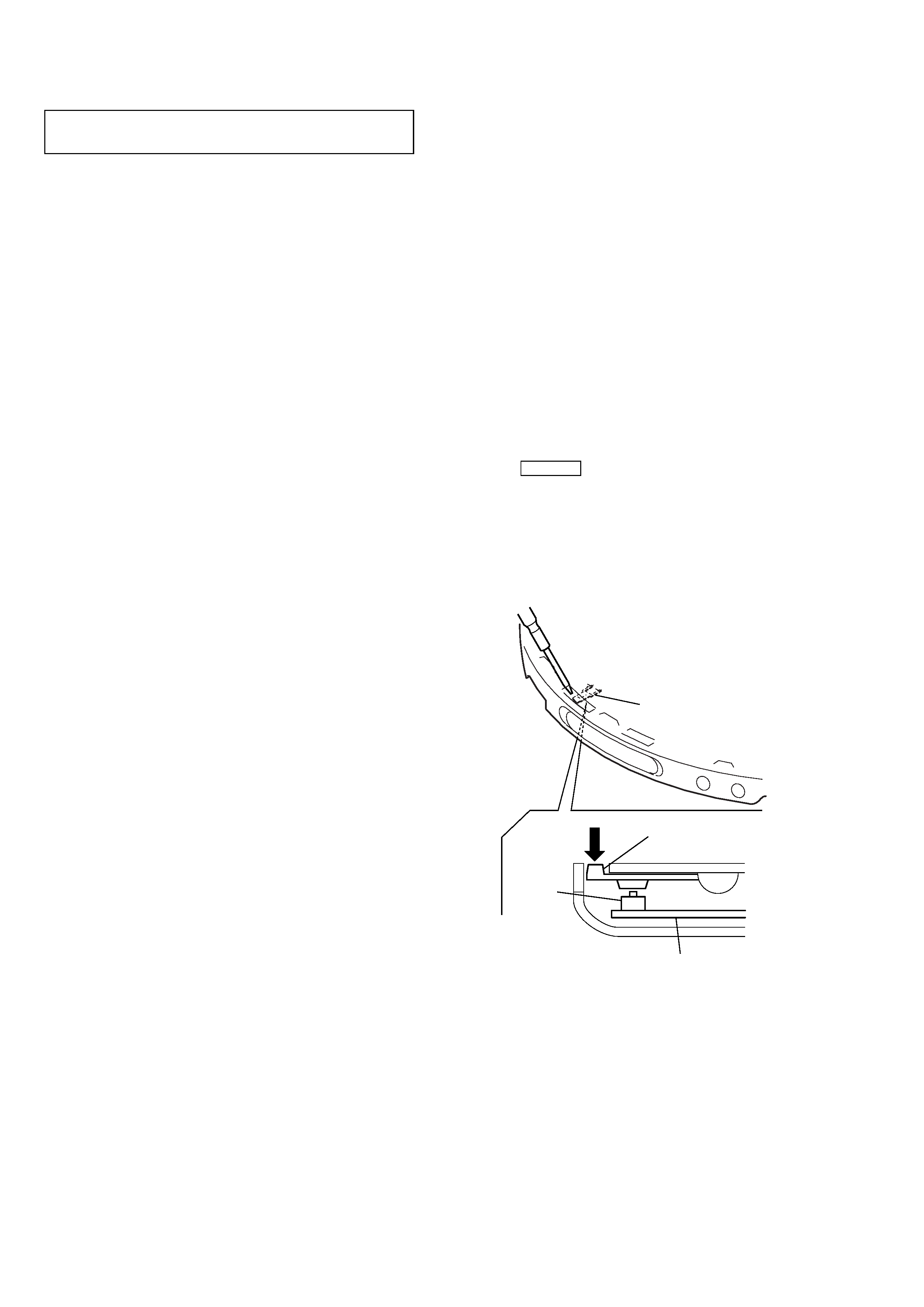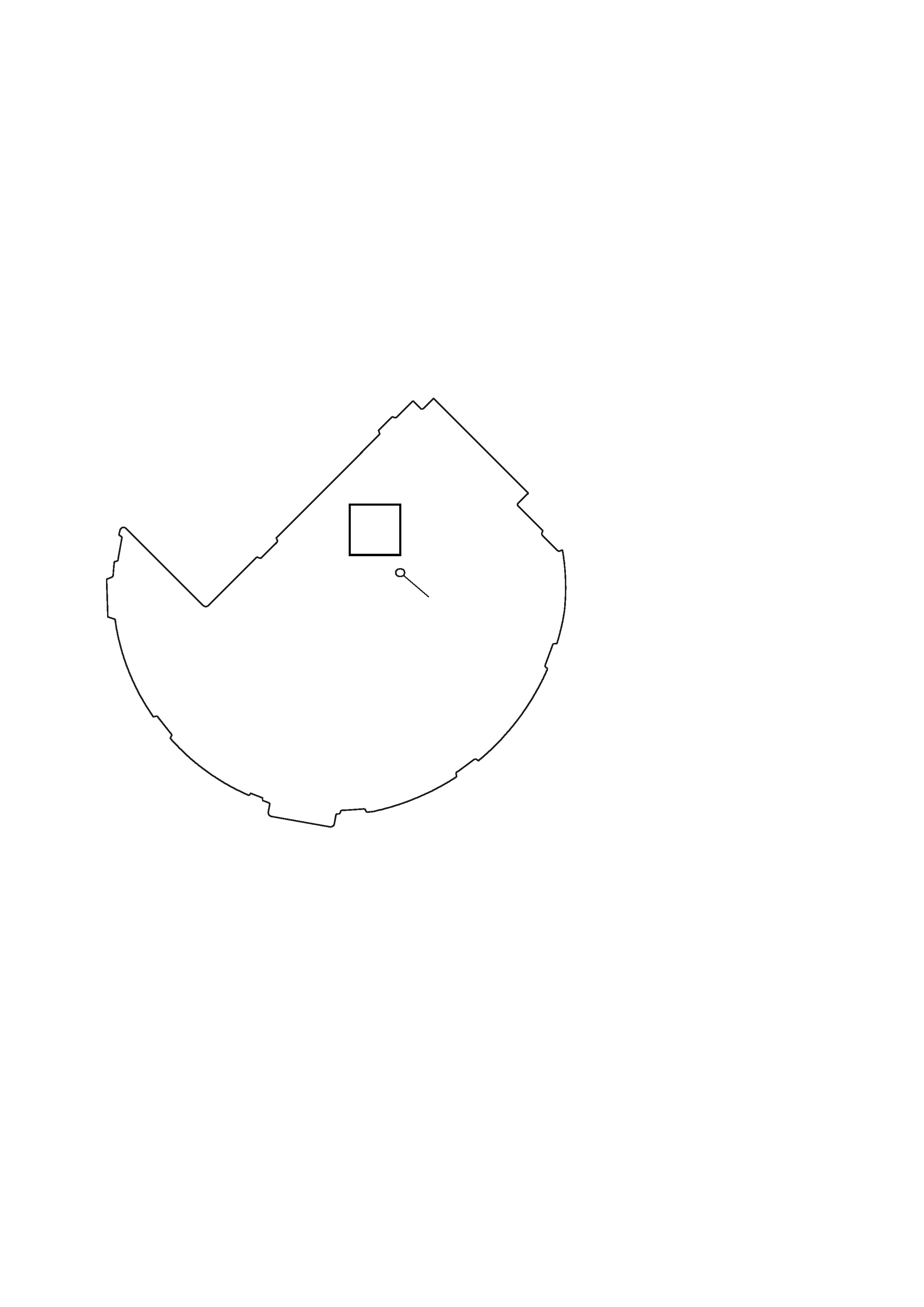
SERVICE MANUAL
Sony Corporation
Personal Audio Company
Published by Sony Engineering Corporation
XP-ZV610/ZV616
US Model
Canadian Model
XP-ZV610
AEP Model
UK Model
XP-ZV616
E Model
XP-ZV610/ZV616
Australian Model
XP-ZV610
PORTABLE CD PLAYER
9-961-546-02
2004D16-1
© 2004.04
Ver 1.1 2004.04
SPECIFICATIONS
Photo : XP-ZV616
System
Compact disc digital audio system
Laser diode properties
Material: GaAlAs
Wavelength:
= 770 - 800 nm
Emission duration: Continuous
Laser output: Less than 44.6
µW
(This output is the value measured at a distance
of 200 mm from the objective lens surface on
the optical pick-up block with 7 mm aperture.)
D-A conversion
1-bit quartz time-axis control
Frequency response
20 - 20 000 Hz
+1
2 dB (measured by JEITA)
Output (at 4.5 V input level)
Headphones (stereo minijack)
Approx. 5 mW + Approx. 5 mW at 16
(Approx. 1.5 mW + Approx. 1.5 mW at 16
)*
* For the customers in Europe
Power requirements
·Two LR6 (size AA) batteries: 1.5 V DC
× 2
·AC power adaptor (DC IN 4.5 V jack)
· Rated current: 500 mA
Battery life*1 (approx. hours)
When you use the CD player on a flat and stable
surface.
When SOUND mode is set to "OFF."
Playing time varies depending on how the CD
player is used.
When using two Sony alkaline batteries
LR6 (SG) (produced in Japan)
E·A·S·S GP
"EASS GP 1" "EASS GP 2"
Audio CD
50
45
ATRAC CD*2
85
85
MP3 CD*3
65
65
*1 Measured value by the standard of JEITA (Japan
Electronics and Information Technology
Industries Association)
*2 Recorded at 48 kbps
*3 Recorded at 128 kbps
Operating temperature
5
°C - 35°C (41°F - 95°F)
Dimensions (w/h/d) (excluding
projecting parts and controls)
Approx. 135.8
× 27.2 × 135.8 mm
(5 3/8
× 1 1/8 × 5 3/8 in.)
Mass (excluding accessories)
Approx. 180 g (6.4 oz.)
US and foreign patents licensed from Dolby
Laboratories.
Design and specifications are subject to change
without notice.
Supplied accessories
AC power adaptor (AC-ES455K)(1)
Earphones (1)
Remote control (1)(XP-ZV616)
CD-ROM* (SonicStage)(1)
User's guide for SonicStage (1)
Operating lnstructions
* Do not play a CD-ROM on an audio CD player.
Model Name Using Similar Mechanism
XP-ZV71
CD Mechanism Type
CDM-3325ER
Optical Pick-up Name
DAX-25E

2
XP-ZV610/ZV616
CAUTION
· INVISIBLE LASER RADIATION
WHEN OPEN
· DO NOT STARE INTO BEAM OR
VIEW DIRECTLY WITH OPTICAL
INSTRUMENTS
· CLASS 1M INVISIBLE LASER
RADIATION WHEN OPEN
· DO NOT VIEW DIRECTLY WITH
OPTICAL INSTRUMENTS
SAFETY-RELATED COMPONENT WARNING!!
COMPONENTS IDENTIFIED BY MARK 0 OR DOTTED LINE WITH
MARK 0 ON THE SCHEMATIC DIAGRAMS AND IN THE PARTS
LIST ARE CRITICAL TO SAFE OPERATION. REPLACE THESE
COMPONENTS WITH SONY PARTS WHOSE PART NUMBERS
APPEAR AS SHOWN IN THIS MANUAL OR IN SUPPLEMENTS
PUBLISHED BY SONY.
Flexible Circuit Board Repairing
·Keep the temperature of the soldering iron around 270
°C during
repairing.
· Do not touch the soldering iron on the same conductor of the
circuit board (within 3 times).
· Be careful not to apply force on the conductor when soldering or
unsoldering.
Notes on chip component replacement
·Never reuse a disconnected chip component.
· Notice that the minus side of a tantalum capacitor may be dam-
aged by heat.
Unleaded solder
Boards requiring use of unleaded solder are printed with the lead-
free mark (LF) indicating the solder contains no lead.
(Caution: Some printed circuit boards may not come printed with
the lead free mark due to their particular size.)
: LEAD FREE MARK
Unleaded solder has the following characteristics.
· Unleaded solder melts at a temperature about 40
°C higher than
ordinary solder.
Ordinary soldering irons can be used but the iron tip has to be
applied to the solder joint for a slightly longer time.
Soldering irons using a temperature regulator should be set to
about 350
°C.
Caution: The printed pattern (copper foil) may peel away if the
heated tip is applied for too long, so be careful!
· Strong viscosity
Unleaded solder is more viscous (sticky, less prone to flow) than
ordinary solder so use caution not to let solder bridges occur such
as on IC pins, etc.
· Usable with ordinary solder
It is best to use only unleaded solder but unleaded solder may
also be added to ordinary solder.
CAUTION
Use of controls or adjustments or performance of procedures
other than those specified herein may result in hazardous radiation
exposure.
On AC power adaptor
· Use only the AC power adaptor supplied.
If your CD player is not supplied with the
one, use the AC-E45HG AC power
adaptor. Do not use any other AC power
adaptor. It may cause a malfunction.
Polarity of the plug
· Do not touch the AC power adaptor with
wet hands.
· Connect the AC power adaptor to an easily
accessible AC outlet. Should you notice an
abnormality in the AC power adaptor,
disconnect it from the AC outlet
immediately.
ATTENTION AU COMPOSANT AYANT RAPPORT
À LA SÉCURITÉ!
LES COMPOSANTS IDENTIFÉS PAR UNE MARQUE 0 SUR LES
DIAGRAMMES SCHÉMATIQUES ET LA LISTE DES PIÈCES SONT
CRITIQUES POUR LA SÉCURITÉ DE FONCTIONNEMENT. NE
REMPLACER CES COMPOSANTS QUE PAR DES PIÈSES SONY
DONT LES NUMÉROS SONT DONNÉS DANS CE MANUEL OU
DANS LES SUPPÉMENTS PUBLIÉS PAR SONY.
Music sources playable on this CD player
You can play the following 3 music sources on this CD player:
·Audio CDs (CDDA format)
· CDs with ATRAC3plus/ATRAC3 format files (ATRAC CD)
· CDs with MP3 format files (MP3 CD)
Usable disc formats
You can use ISO 9660 Level 1/2 and Joliet extension format discs only.
About CD-Rs/RWs
This CD player can play CD-Rs/RWs recorded in the ATRAC3plus/ATRAC3, MP3 or CDDA*
format, but playback capability may vary depending on the quality of the disc and the condition
of the recording device.
* CDDA is the abbreviation for Compact Disc Digital Audio. It is a recording standard used for the Audio
CDs.
Music discs encoded with copyright protection technologies
This product is designed to playback discs that conform to the Compact Disc (CD) standard.
Recently, various music discs encoded with copyright protection technologies are marketed by
some record companies. Please be aware that among those discs, there are some that do not
conform to the CD standard and may not be playable by this product.
Notes
·This CD player cannot record music content on recordable media, such as CD-Rs/RWs.
· CD-Rs/RWs recorded in the ATRAC3plus/ATRAC3 format cannot be played on your computer.

3
XP-ZV610/ZV616
TABLE OF CONTENTS
1. SERVICING NOTE ....................................................... 4
2. GENERAL ....................................................................... 6
3. DISASSEMBLY
3-1.
Cabinet (Front) Assy ....................................................... 9
3-2.
CD Mechanism Deck (CDM-3325ER), MAIN Board .... 10
3-3.
Upper Lid ........................................................................ 11
3-4.
CONTROL Board ........................................................... 12
3-5.
Motor Assy (Sled)(M902), Optical Pick-up (DAX-25E),
Turn Table Motor Assy (Spindle)(M901) ........................ 13
4. ELECTRICAL CHECKING ........................................ 14
5. DIAGRAMS ..................................................................... 15
5-1.
Block Diagram ................................................................ 16
5-2.
Printed Wiring Board MAIN Board (Side A) ............ 17
5-3.
Printed Wiring Board MAIN Board (Side B) ........... 18
5-4.
Schematic Diagram MAIN Board (1/4) .................... 19
5-5.
Schematic Diagram MAIN Board (2/4) .................... 20
5-6.
Schematic Diagram MAIN Board (3/4) .................... 21
5-7.
Schematic Diagram MAIN Board (4/4) .................... 22
5-8.
Printed Wiring Board CONTROL Board .................. 23
5-9.
Schematic Diagram CONTROL Board ..................... 24
5-10. IC Pin Function Description ............................................ 30
6. EXPLODED VIEWS
6-1.
Overall Section ................................................................ 32
6-2.
Cabinet Lower Section .................................................... 33
6-3.
Upper Lid Section ........................................................... 34
6-4.
CD Mechanism Section (CDM-3325ER) ........................ 35
7. ELECTRICAL PARTS LIST ...................................... 36

4
XP-ZV610/ZV616
SECTION 1
SERVICING NOTE
The laser diode in the optical pick-up block may suffer electrostatic
breakdown because of the potential difference generated by the
charged electrostatic load, etc. on clothing and the human body.
During repair, pay attention to electrostatic breakdown and also use
the procedure in the printed matter which is included in the repair
parts.
The flexible board is easily damaged and should be handled with
care.
NOTES ON LASER DIODE EMISSION CHECK
The laser beam on this model is concentrated so as to be focused on
the disc reflective surface by the objective lens in the optical pick-
up block. Therefore, when checking the laser diode emission,
observe from more than 30 cm away from the objective lens.
BEFORE REPLACING THE OPTICAL PICK-UP BLOCK
Please be sure to check thoroughly the parameters as par the "Optical
Pick-Up Block Checking Procedures" (Part No.: 9-960-027-11)
issued separately before replacing the optical pick-up block.
· FOK output: IC601 yg pin
When checking FOK, remove the lead wire to disc motor.
· RF signal P-to-P value: 0.45 to 0.65 Vp-p
LASER DIODE AND FOCUS SEARCH OPERATION
CHECK
During normal operation of the equipment, emission of the laser
diode is prohibited unless the upper lid is closed while turning ON
the S820. (push switch type)
The following checking method for the laser diode is operable.
· Method:
Emission of the laser diode is visually checked.
1. Open the upper lid.
2. With a disc not set, turn on the S820 with a screwdriver having a
thin tip as shown in Fig.1.
3. Press the u/ENT button.
4. Observing the objective lens, check that the laser diode emits
light.
When the laser diode does not emit light, automatic power control
circuit or optical pickup is faulty.
In this operation, the objective lens will move up and down 4
times along with inward motion for the focus search.
NOTES ON HANDLING THE OPTICAL PICK-UP
BLOCK OR BASE UNIT
Fig. 1 Method to push the S820
S820
lever (lid detection)
lever (lid detection)
MAIN board

5
XP-ZV610/ZV616
TEST MODE
The software version display and LCD test can be performed when
the test mode is activated.
Procedure:
1. Confirm the set is not powered on. (Remove two batteries and
disconnect the AC power adaptor.)
2. Short the solder land SL824 (TEST) on the MAIN board.
3. Turn on the main power. (Insert two batteries.)
4. Microcomputer version is displayed for about a second.
5. After that all segments of the liquid crystal display are turned
on.
6. Turn off the main power. (Remove two batteries.)
7. Open the solder land SL824 (TEST) on the MAIN board.
Note : The solder should be removed clean.
IC801
MAIN BOARD (SIDE B)
SL824
(TEST)
